Chapter 4.1—Top 5 Ways to Pay Attention in Dull Meetings
Today, we’ll wrap things up for a short while (while I do more research I just discovered—score!) and sum-up what we’ve found so far.
• • • • •
In the last twelve months there’s been an enormous amount of research released on doodling and mindfulness and before that (2003) Dr. Benson directly linked mindfulness and knitting* (1) and in 2010 Jackie Andrade released her doodling study (2). Even more studies are being released now–once again, we’re in a zeitgeist (reliving CraftLit).
I wanted to take a couple of weeks to review the new research, then come back and add to this site. I have a couple of speaking engagements coming up on this topic (email if you want me to come speak at your school or guild or shop) and want to be sure to fold this new data in before it gets cold.
In the meantime, however, I thought we should have a quick-and-dirty list of what to tell people when they accuse you of not paying attention when you knit or crochet or doodle at meetings, on calls, or when in a group where lots of people are talking.
Top Five Ways to Pay Attention in Dull Meetings
- Doodle: like this—
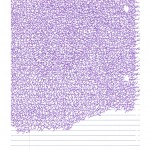 — not like this —
— not like this —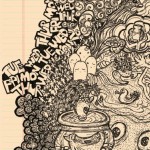
- Knit: like this—
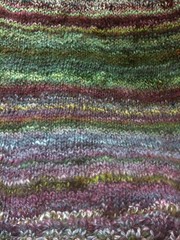 — not like this —
— not like this —
- Crochet: like this—
 — not like this —
— not like this — 
- Sketchnote
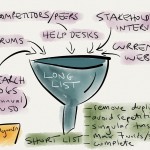
- Anything you can do with a level of automaticity that doesn’t require any sustained visual focus
The byproduct of these kinds of cognitive anchors are:
- they keep your mood up…
- which helps you be more productive at work…
- and helps you to attend to the present rather than the past or the future (mindfulness rather than scateredness)…
- and these anchors let you focus on tasks that need focus and can also help you creatively solve problems when you engage in these activities during down-time…
- so you remember up to 29% more of what you hear in meetings and are up to 31% more productive at your job (whether it’s being a corporate drone, a high-powered manager, a teacher, a WAHM or a SAHM—doesn’t matter. We all work better when we’re mindful and happy).
Our friend Shawn Achor found if you spend just 24 days doing the following five things you will find yourself living constantly and habitually in that positive place we’d all like to live:
I’m willing to bet you already do half of those things if not more. But you may have been keeping your light under a bushel since there are lots of judgy people out there who give us weird looks or make cracks about doodling or knitting or crocheting in public. Personally, I’ve never had much trouble going against the grain and have had an easy time explaining to muggles what I’m up to and why it’s a good thing. But after talking to lots of other crafty-types, I’ve gotten the picture that I’m not normal.
Heh.
So now you have this site—and particularly this summary page. If you just stumbled here, the points I enumerated above are all explained in more detail in the previous posts. If you’ve read through, I hope this page can help you convince others that you’re doing the right thing when you engage in your automatic activity. I know knitters are excellent pushers enablers and always happy and ready to teach a willing victim student. Now I hope you can use this site to really help others achieve the level of calm attention that you already are able to live in without breaking a sweat. Life is hard and we need every trick we can collect to help us stay in a good place. And knitters, crocheters, and doodlers have known for a long time just how helpful our automatic actives have been for us.
Now we can prove it.
I’ll be back soon. Until then, take care and listen to a good book,
*Actually in this study he links mindfulness and needlepoint, but one of my audience members when I spoke to the Common Cod Fiber Guild at MIT told me that Dr. Benson (who is in Boston) had later included knitting in his list of positive triggers.
Works Consulted (so far)
Achor, S. TED talk; The Happy Secret to Better Work. goodthinkinc.com/speakers/shawn-achor/
Andrade, J. (2010). What does doodling do? Applied Cognitive Psychology, 24(1), 100.
Baddeley, A., Papagno, C., & Andrade, J. (1993). The sandwich effect: The role of attentional factors in serial recall. Journal of Experimental Psychology, 19(4), 862-862.
Baddeley, A. D., & Andrade, J. (2000). Working memory and the vividness of imagery. Journal of Experimental Psychology, 129(1), 126-145.
Benson, H., & Proctor, W. (2003, Triggers for a happier life. The Saturday Evening Post, 275, 38-39,76,78,85-87.
Brown, Sunni. www.ted.com/talks/sunni_brown.html.
Carriere, J. S. A., Seli, P., & Smilek, D. (2013). Wandering in both mind and body: Individual differences in mind wandering and inattention predict fidgeting. Canadian Journal of Experimental Psychology, 67(1), 19-31.
Coontz, R. J. (2013, Q&a. Muse, 17, 13-13.
Corkhill, Betsan. www.knitonthenet.com/issue4/features/therapeuticknitting/
de Lange, C. (2012, Superdoodles. New Scientist, 216, 56.
Dixon, P., & Bortolussi, M. (2013). Construction, integration, and mind wandering in reading. Canadian Journal of Experimental Psychology, 67(1), 1-10.
Hamalainen, K. (2009, Sep 21). Battling boredom. Science World, 66, 4-4.
McVay, J. C., Kane, M. J., & Kwapil, T. R. (2009). Tracking the train of thought from the laboratory into everyday life: An experience-sampling study of mind wandering across controlled and ecological contexts. Psychonomic Bulletin & Review (Pre-2011), 16(5), 857-63.
McVay, J. C., Unsworth, N., McMillan, B. D., & Kane, M. J. (2013). Working memory capacity does not always support future-oriented mind-wandering. Canadian Journal of Experimental Psychology, 67(1), 41-50.
Mooneyham, B. W., & Schooler, J. W. (2013). The costs and benefits of mind-wandering: A review. Canadian Journal of Experimental Psychology, 67(1), 11-8.
Richard J Davidson With,Sharon Begley. (2012, Mar 05). The new science of feelings. Newsweek, 159
Schott, G. D. (2011). The art of medicine: Doodling and the default network of the brain. The Lancet, 378(9797), 1133-4.
Smallwood, J., McSpadden, M., & Schooler, J. W. (2007). The lights are on but no one’s home: Meta-awareness and the decoupling of attention when the mind wanders. Psychonomic Bulletin & Review (Pre-2011), 14(3), 527-33.
Smallwood, J., McSpadden, M., & Schooler, J. W. (2008). When attention matters: The curious incident of the wandering mind. Memory & Cognition (Pre-2011), 36(6), 1144-50.
Smallwood, J., & Schooler, J. W. (2006). The restless mind. Psychological Bulletin, 132(6), 946-946.
Thayer, R. E. (2001). Calm energy: How people regulate mood with food and exercise. United Kingdom, Hampshire: MyiLibrary Ltd., Oxford University Press USA.
1 Comment













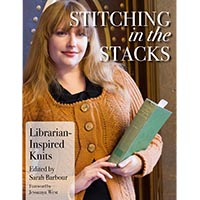





Love it! I have been “excused” many times in life for seeming to not be listening while fiddling with something else. I like the dos and don’ts, that’s really insightful! Thank you!